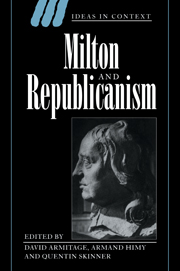Book contents
- Frontmatter
- Contents
- Notes on contributors
- Preface
- PART I DEFINING MILTON'S REPUBLICANISM
- PART II MILTON AND REPUBLICAN LITERARY STRATEGY
- PART III MILTON AND THE REPUBLICAN EXPERIENCE
- 8 Popular republicanism in the 1650s: John Streater's ‘heroick mechanicks’
- 9 Milton and Marchamont Nedham
- 10 Milton and the Protectorate in 1658
- 11 John Milton: poet against empire
- PART IV MILTON AND THE REPUBLICAN TRADITION
- Index
- Recent titles in the series include
9 - Milton and Marchamont Nedham
Published online by Cambridge University Press: 27 October 2009
- Frontmatter
- Contents
- Notes on contributors
- Preface
- PART I DEFINING MILTON'S REPUBLICANISM
- PART II MILTON AND REPUBLICAN LITERARY STRATEGY
- PART III MILTON AND THE REPUBLICAN EXPERIENCE
- 8 Popular republicanism in the 1650s: John Streater's ‘heroick mechanicks’
- 9 Milton and Marchamont Nedham
- 10 Milton and the Protectorate in 1658
- 11 John Milton: poet against empire
- PART IV MILTON AND THE REPUBLICAN TRADITION
- Index
- Recent titles in the series include
Summary
Milton's friendships can be hard to imagine. He yearned for friendship and treasured it when he found it. True friendship, he believed, survived when tested. It extended beyond conventional courtesies to Platonic unions of souls. His early biographers tell us of the ‘greatness’ or ‘intimacy’ or ‘particularity’ of his friendships with Charles Diodati, with the wits of the Florentine academies, with Cyriack Skinner or Andrew Marvell or Edward Lawrence in England. Yet the Milton we meet in his writings can seem a proudly solitary figure. Elsewhere in this volume (p. 117, n. 58) Roger Lejosne fittingly emphasizes the ‘loneliness’ of the stand of Abdiel in Paradise Lost, ‘which puts him in the same company with such isolated heroes, so dear to the poet's heart, as Samson, Jesus, and no doubt Milton himself’. Milton cannot bring his friendships to life on the page, where they remain imprisoned within the conventions he wishes them to transcend. They seem witnesses less to intimacy than to the poet's egocentricity. Lycidas is ostensibly a poem on the death of Milton's friend Edward King, but famously tells us less about King than about Milton. When, in ‘Mansus’, Milton sighs for a friendship akin to that which had bound his friend John Baptista Manso to the poet Torquato Tasso, it is in the hope that Milton, like Tasso, will become, in an old age ripe with poetic triumph, the centre of a friend's attention. In prose, Milton addresses Of Reformation ‘to a friend’ in 1641 and writes the political tract A Letter to a Friend in 1659.
- Type
- Chapter
- Information
- Milton and Republicanism , pp. 156 - 180Publisher: Cambridge University PressPrint publication year: 1995
- 27
- Cited by



